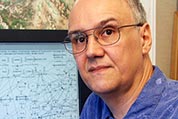




When the A&B water call came in to the Department of Water Resources, Tony Morse, the geospatial technology manager (recently retired), and Bill Kramber, a remote sensing analyst, had just started to analyze water use throughout the state during 2006. The department had been using satellite-based estimates of water use for a couple of years at that point.
The challenge in refereeing water disputes, or managing a water supply in general, has always been figuring out how much water is actually being used. Most of us think of 'water use' as the water we are billed for every month. But for state water managers, 'water use' has a different meaning.
Water resource managers are like bankers: they track the entire water supply like bankers track all of the money in their bank. Each individual water user has the right to withdraw the water in his or her account. But when people withdraw water for washing dishes or taking showers, most of it flows back into the sewers. And when farmers irrigate their fields, some of the water runs back into rivers or soaks into the ground.
Since a portion of all water withdrawals are re-deposited into the water supply, it is as if funds are simply being transferred from one individual account to another in the bank. Since the total amount of water in the bank hasn’t changed, the water has not been ‘used’ from the water manager’s perspective.
Water is only used, or "spent," when it is removed from the bank entirely, and that happens when it evaporates from the ground or is soaked up by growing plants and released (transpired) as water vapor during photosynthesis. A water meter, such as those on the wells that Dean Stevenson uses to pump irrigation water from the Snake River Plain aquifer, tracks how much water a user withdraws, but not how much is actually spent.
To track farmers' water spending, the Department of Water Resources needs to measure evapotranspiration (evaporation plus transpiration) across millions of acres of cropland. Previously, they estimated evapotranspiration for each county from temperature, humidity, wind speeds, and sunlight measured at regional weather stations.
That approach works to track the total amount of water in the bank, but it falls short for deciding how much water an individual user is spending. Water is managed on a field-by-field basis, notes Morse. Conflicts occur on a field-level basis. To settle water disputes like the A&B water call in 2006 and to make decisions about future water use, the department needed to measure evapotranspiration at the field level for the entire state—a formidable task.
"Remote sensing was the only way to throw a rope around all the water consumption going on in Idaho," says Rick Allen, a water resources engineer at the University of Idaho. With a grant from NASA in 2000, Allen and Morse began looking for ways to use data from the Landsat satellites to estimate evapotranspiration across the Snake River Plain and other farmland in Idaho. With the ability to see the ground in greater detail than many other science satellites, the Landsat satellites were NASA's missions specifically designed to study the Earth’s land surface. Landsat sees 30 meters square in a single image pixel—the perfect resolution for monitoring individual fields of crops.